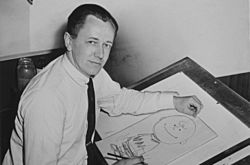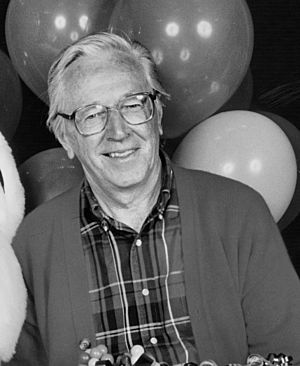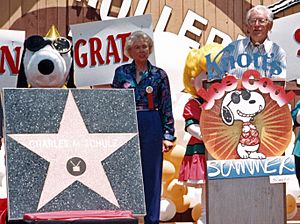Charles M. Schulz facts for kids
Quick facts for kids Charles Monroe Schulz |
|
|---|---|

Charles M. Schulz in 1956, drawing Charlie Brown
|
|
| Born | Charles Monroe Schulz November 26, 1922 St. Paul, Minnesota, U.S. |
| Died | February 12, 2000 (aged 77) Santa Rosa, California, U.S. |
| Nationality | American |
| Area(s) | Cartoonist |
|
Notable works
|
Peanuts (1950–2000) |
| Signature | |
Charles Monroe Schulz (born November 26, 1922 – died February 12, 2000), often called Sparky, was an American cartoonist. He is most famous for creating the comic strip Peanuts. This beloved strip featured characters like Charlie Brown and Snoopy. Many people think he was one of the most important cartoonists ever. Other famous cartoonists, like Bill Watterson who created Calvin and Hobbes, said Schulz greatly influenced their work.
Contents
Schulz's Cartooning Journey
Charles Schulz started his cartooning career with a weekly series called Li'l Folks. These were one-panel jokes published from 1947 to 1950. In Li'l Folks, Schulz first used the name Charlie Brown for a character. He even drew a dog that looked a lot like Snoopy in this early series.
Schulz also sold some of his drawings to The Saturday Evening Post. He published 17 drawings there between 1948 and 1950.
The World of Peanuts
Peanuts became incredibly popular around the world. At its peak, it was printed every day in 2,600 newspapers. These papers were in 75 countries and 21 different languages.
Over almost 50 years, Schulz drew nearly 18,000 Peanuts comic strips. He only took one vacation during this time, a five-week break in 1997. During his vacation, old strips were shown, which was the only time this happened while he was alive.
The first book of Peanuts strips came out in 1952. Many more books followed, helping the comic strip become even more famous. Peanuts also became popular on TV. The first animated TV special, A Charlie Brown Christmas, aired in 1965. It even won an Emmy award! Many other TV specials were made, and Schulz wrote or co-wrote them. He also made sure they were produced just right.
Schulz often got ideas for Peanuts from his own life. For example:
- Charlie Brown's dad was a barber, just like Schulz's father.
- Schulz said he often felt shy, much like Charlie Brown.
- He had an intelligent dog as a boy, which inspired Snoopy. His dog was a pointer, not a beagle like Snoopy, but they looked a bit alike.
- Snoopy's brother Spike lived near Needles, California. Schulz's family lived there for a few years when he was young.
- The Little Red-Haired Girl, who Charlie Brown liked, was inspired by a woman Schulz fell in love with. She turned down his marriage proposal.
- Characters like Linus and Shermy were named after Schulz's real-life friends.
- Peppermint Patty was inspired by his cousin, Patricia Swanson. Schulz named her after seeing peppermint candies.
Schulz's Other Interests
Besides comics, Schulz loved art. His favorite artist later in life was Andrew Wyeth. He also loved classical music. While the character Schroeder in Peanuts loved Beethoven, Schulz's favorite composer was said to be Brahms.
His Final Years
In 1981, Schulz had heart surgery. President Ronald Reagan even called him in the hospital to wish him well.
People often asked Schulz if Charlie Brown would finally get to kick the football in the last Peanuts strip. (In the comics, Lucy always pulled the football away at the last moment.) Schulz said no, because it would be unfair to Charlie Brown. But later, he felt sad that Charlie Brown never got to kick it.
Schulz's Passing
Charles Schulz passed away peacefully at home on February 12, 2000. He had been battling an illness. The very last original Peanuts comic strip was published the next day, February 13. Schulz had always thought the comic strip would continue after him.
Schulz had a special request in his contract. He asked that no other artist be allowed to draw the Peanuts comic strip. The company that owned the strip respected his wishes. They decided to show reruns of the old strips in newspapers instead. New Peanuts TV specials have been made since his death, but their stories are based on his original strips.
On May 27, 2000, over 100 cartoonists honored Schulz. They included his characters in their own comic strips that day.
Awards and Honors
Schulz received many awards for his work. He won the National Cartoonists Society's Humor Comic Strip Award in 1962. He was also the first person to win their Reuben Award twice, in 1955 and 1964. In 1999, he received their Lifetime Achievement Award.
Schulz supported space travel. Because of this, the Apollo 10 command module was named Charlie Brown. The lunar module was named Snoopy. These were launched into space in 1969.
In 1974, Schulz was the Grand Marshal of the Rose Parade in Pasadena, California.
Schulz loved playing bridge. Sometimes, he even put bridge references in Peanuts. In 1997, the American Contract Bridge League (ACBL) gave Snoopy an honorary "Life Master" rank. Schulz was very happy about this.
In 2007, Schulz was added to the United States Figure Skating Hall of Fame. He also received the Harvey Kurtzman Hall of Fame Award in 2014.
Schulz's Legacy
Charles Schulz left behind a wonderful legacy that continues to entertain and inspire.
In 1983, Camp Snoopy opened at Knott's Berry Farm. This is a theme area with rides for younger children, all featuring the Peanuts characters. It's a very popular part of the park.
When the Mall of America opened in 1992, its amusement park was also themed around Peanuts. This lasted until 2006.
The Jean and Charles Schulz Information Center at Sonoma State University opened in 2000. It's one of the largest buildings in California's university system. It was named after Schulz and his wife, who donated money to help build it.
In 2000, the airport in Sonoma County was renamed the Charles M. Schulz–Sonoma County Airport. The airport's logo shows Snoopy flying on top of his red doghouse.
St. Paul, Minnesota, Schulz's hometown, created "Peanuts on Parade." In 2000, they placed 101 five-foot-tall statues of Snoopy around the city. Each summer for four years, statues of different Peanuts characters were placed on sidewalks. These statues were later auctioned off. Some remain in the city, and permanent bronze statues of the characters are in downtown St. Paul.
The Charles M. Schulz Museum and Research Center opened in Santa Rosa in 2002. It celebrates his life's work and the art of cartooning. A bronze statue of Charlie Brown and Snoopy is in Depot Park in downtown Santa Rosa.
In 2005, Santa Rosa, California, celebrated the 60th anniversary of the comic strip. They continued the "Peanuts on Parade" tradition with different character themes each year.
Schulz's work continues to be very successful. In 2006, Forbes magazine said he was the third-highest earning deceased celebrity.
Bill Watterson, the creator of Calvin and Hobbes, wrote about Schulz in 2007. He said Peanuts defined what a modern comic strip is. Watterson noted Schulz's simple drawings, funny humor, honest feelings, and how he showed the inner thoughts of a pet. He also mentioned the huge amount of Peanuts merchandise. Watterson said Schulz "blazed the wide trail that most every cartoonist since has tried to follow."
Images for kids
-
Schulz's star on the Hollywood Walk of Fame
See also
 In Spanish: Charles M. Schulz para niños
In Spanish: Charles M. Schulz para niños








